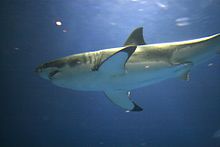Monterey Bay Aquarium
Early proposals to build a public aquarium in Monterey County were not successful until a group of four marine biologists affiliated with Stanford University revisited the concept in the late 1970s.
Monterey Bay Aquarium was built at the site of a defunct sardine cannery and has been recognized for its architectural achievements by the American Institute of Architects.
[2] Nancy Burnett brought the group's interest to her parents, Lucile and David Packard (co‑founder of Hewlett-Packard), and their foundation commissioned a feasibility study.
[d][c] Due to an expansion of its planned exhibits—after visits to public aquariums in Japan—and the design and creation of exhibits in‑house, the Packards paid a final sum of $55 million.
Nearly half of the aquarium would be located over the bay in depths of up to 120 ft (37 m), requiring foundational elements to be installed during low tide, which often occurred at night.
[i] Various elements of the building mirrored that of Hovden Cannery, including its windows (to let in sunlight), plain cement walls, structural protection from waves and storms, and its many roofs.
"[k] Throughout the following year, 2.4 million people visited,[l] which influenced assumptions about "the ability of marine life to entertain, educate, and promote a city.
[n] The idea to display marine habitats was inspired by the work of ecologist Ed Ricketts in his 1939 book on intertidal ecology, Between Pacific Tides.
The use of unfiltered seawater allows animals to grow in the aquarium's plumbing so it must occasionally be cleaned with tools called pigs, which blast through the pipes under pressure to remove organisms and debris.
[v] The exhibit's success at sustaining giant kelp and its realistic appearance are attributed to the availability of direct sunlight, the use of natural seawater from Monterey Bay, and a surge machine (a large plunger) that replicates California's pulsing water currents.
[x] The 5-foot (1.5 m) surge machine, which plunges every 6 seconds,[v] allows the kelp in the exhibit to grow an average of 4 inches (10 cm) per day and was designed and constructed by David Packard.
[y][15] It consists of three separate galleries: various jellyfish and other plankton found in the bay; a pelagic, large community exhibit; and "ocean travelers", which features tufted puffins and sea turtles.
[y] Six great white sharks were displayed in the Open Sea exhibit between 2004 and 2011, an effort contested by some but generally described as having a positive scientific and educational impact.
Supplemental exhibits were added as part of this renovation featuring artwork that highlights current issues in ocean conservation, including overfishing and marine plastic pollution.
[28] Its content was successfully accessible and compelling to the public, but the exhibition was criticized for its narrow "consumerist approach" to climate change communication—promoting individual, marketplace-based actions rather than collective political ones.
Staff members attribute the organization's fascination with jellyfish to their visual appeal, primitive biology, and reputed calming effect on visitors.
[ai] Staff scientists have authored scientific publications involving sea otters, great white sharks, and bluefin tunas, which are important species in the northern Pacific Ocean.
As of October 2017,[update] more than 800 individuals had completed the rehabilitation program and researchers have collected data on wild sea otter populations using electronic tags.
[45][ah] Pacific bluefin and yellowfin tunas have been historically displayed in the Open Sea community exhibit, some reaching more than 300 pounds (140 kg).
Since 1985, the aquarium has been deeply involved in jellyfish propagation,[note 5] creating three temporary exhibitions and one permanent gallery (within the Open Sea wing).
[27][50] In partnership with Monterey Bay Aquarium Research Institute, at least two deep-sea cephalopod species were displayed in the exhibition, including flapjack octopuses and the vampire squid.
"[59] It began in 1999 as a result of a popular component of a temporary exhibition and has grown to consist of a website, six regional pocket guides, and mobile apps that allow consumers to check the sustainability ratings of specific fisheries.
The program has expanded to include business collaborations, local and national restaurant and grocer partnerships, and outreach partnerships—primarily other public aquariums and zoos.
[64] Monterey Bay Aquarium plays an active role in federal and state politics, from sponsoring governmental legislation about the ocean[65] to persuading voter action from its visitors and online followers.
[av] In support of California Proposition 67 (2016), the organization produced advertisements, web pages, and podcasts in favor of a statewide ban on single-use plastic grocery bags.
[ax] The Bechtel Family Center for Ocean Education and Leadership, a 13,000-square-foot (1,200 m2) facility, was proposed in 2018 with an initial estimated construction cost of US$30 million.
[81] An annual event called "Día del Niño" offers bilingual feeding presentations (in Spanish), activities, and free admission for children under the age of 13.
[84] In December 2020, Natividad Medical Center in Salinas was loaned a deep-freeze fridge from the Aquarium in order to allow the hospital to store the Pfizer–BioNTech COVID-19 vaccine at -94 degrees Fahrenheit.
[92][93] In 2015, it was listed by Parents magazine as the top public aquarium in the United States and the highest rated destination on the West Coast.
[95] Each year, since 2019, content creator DougDoug has held a Twitch livestream on the birthday of Monterey Bay Aquarium's oldest sea otter, Rosa.





